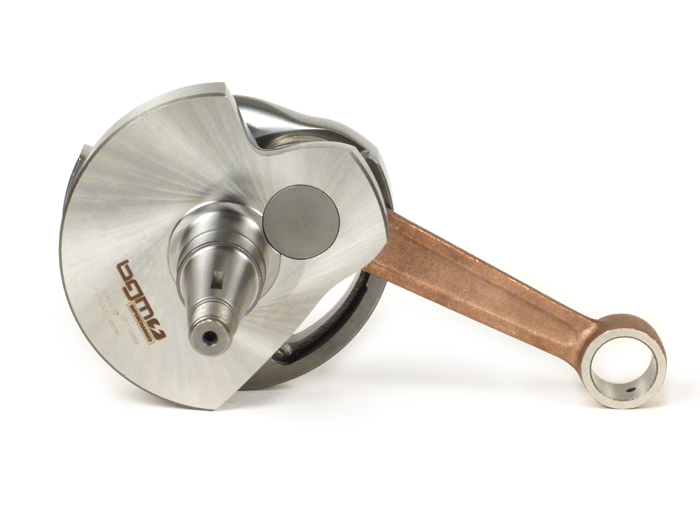Crankshaft Vespa PX80
Many people still know it and may have discovered their love for the Vespa on this scooter: The
Vespa PX80, which was only built by Piaggio for the German market.

80cc - the German way
With the end of the old regulation, which was valid in Germany until 14.02.1996, 80cc up to a maximum of 80km/h, the sale of the PX80 in Germany was also discontinued. Unfortunately, the supply of spare parts from Piaggio also became very scarce. For a long time there was no alternative to the expensive, original and difficult to obtain Piaggio PX80 crankshaft. In the meantime, however, the PX80 has emerged from its shadowy existence behind the PX200, which is favored in Germany, and there is a loyal fan base for the smallest engine in the PX family.
Vespa PX80 tuning
With the right components, the PX80 can also experience a charming second or third spring and catch up with the performance of its big sister. Proven acquaintances here are
"the 139" from Malossi and
"the 135" from Diffusione Ricambi, DR for short. While Pinasco tried to go one better with the 149 aluminum cylinder, Polini never tried its hand at the PX80.
Vespa PX80 crankshaft - the weak point
Regardless of which cylinder drove the PX80's power unit, the original crankshaft went the usual way: due to the loss of the thrust washers and the resulting death of the lower connecting rod bearing, it quit its job - so good advice was expensive.
The solution: our Vespa PX80 crankshaft from bgm PRO
Experience teaches wisdom, which is why we have given the high-torque PX80 a new lease of life with our bgm PRO
crankshaft for Vespa PX80 with a set of sturdy thrust washers.

With the bgm crankshaft, there is finally a suitable replacement for the small PX engine. The bgm standard crankshaft with 48mm stroke only has a slightly longer intake time.

Other crankshaft manufacturers design a much too large opening angle for the PX80, the result is that the cylinders with the small timing angles in conjunction with the small intake provided by the "anti-tuning holes" no longer run useably in the lower speed range. The tunability of such engines also suffers greatly due to the excessive opening angle.
Also available as a long-stroke Vespa PX80 crankshaft
To make wrenching on the PX80 fun again, we have also produced a
"long-stroke version" of the bgm crankshaft. With a
51mm stroke on the small engine, other performance values can be achieved and the existing cylinders benefit from the raised control angles.

Comparison of long-stroke and standard shaft
Here is a quick comparison when using the different cylinders on 48mm and 51mm stroke.
| Standard stroke 48mm |
Exhaust angle° |
Overcurrent angle° |
Pre-discharge° |
| DR135 |
155 |
115 |
20 |
| Malossi 139 |
182 |
120 |
31 |
| SC Conversion cylinder 125cc |
155 |
110 |
22,5 |
| Long stroke 51mm |
Exhaust angle° |
Overcurrent angle° |
Pre-discharge° |
| DR135 +head gasket 1.5mm |
158 |
121 |
18,5 |
| DR135 head gasket 1.5mm (+ 2mm outlet height) |
168 |
121 |
23,5 |
| Malossi 139 Head gasket 1,5mm |
184 |
126 |
29 |
| Malossi 139 head gasket 2,0mm (foot -0,5mm) |
182 |
124 |
29 |
| SC Conversion cylinder 125cc Head gasket 1,5mm |
158 |
117 |
20,5 |
| SC conversion cylinder 125cc head gasket 1.5mm (+ 2mm exhaust height) |
168 |
117 |
25,5 |
Tip: Pay attention to the correct gear ratio
If the PX80 is fitted with a cylinder with a larger displacement, the
primary reduction ratio should always be changed as well. The PX80 has the shortest version with 20/68 teeth. For the original clutch with 6 springs and a diameter of 108 mm, the following are required
Clutch pinions A clutch for life:
Alternatively, the entire clutch can be replaced. The
BGM Superstrong also fits into the PX80 after a few minor modifications and can be operated with the primary wheel of the 80cc. Here too, there are variants with 20, 21, 22 and 23 teeth.



 With the bgm crankshaft, there is finally a suitable replacement for the small PX engine. The bgm standard crankshaft with 48mm stroke only has a slightly longer intake time.
With the bgm crankshaft, there is finally a suitable replacement for the small PX engine. The bgm standard crankshaft with 48mm stroke only has a slightly longer intake time. Other crankshaft manufacturers design a much too large opening angle for the PX80, the result is that the cylinders with the small timing angles in conjunction with the small intake provided by the "anti-tuning holes" no longer run useably in the lower speed range. The tunability of such engines also suffers greatly due to the excessive opening angle.
Other crankshaft manufacturers design a much too large opening angle for the PX80, the result is that the cylinders with the small timing angles in conjunction with the small intake provided by the "anti-tuning holes" no longer run useably in the lower speed range. The tunability of such engines also suffers greatly due to the excessive opening angle.
